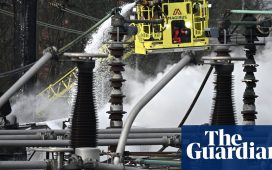The UK, along with many governments around the world, is placing its faith in carbon capture and storage, the technology that can keep carbon dioxide emissions from entering the atmosphere.
The government has committed almost £22bn over 25 years to developing CCS in a big investment promise designed to reignite Britain’s struggling industrial heartlands.
But does CCS work, and how can the UK afford it?
What is carbon capture and storage (CCS)?
The key aim of CCS is to stop CO2 escaping into the atmosphere and exacerbating the climate crisis.
The components of CCS have been around for decades: they are a group of technologies that can capture the carbon dioxide produced by big factories and power plants, preventing them from reaching the atmosphere and contributing to global heating, then transport them, bury them or reuse them.
In most versions, the preliminary step involves fitting factory chimneys with solvent filters to trap carbon emissions. The gas can then be piped to locations where it can be used or stored.
Most carbon dioxide will be injected deep underground – where fossil fuel gas comes from in the first place – to be stored where it cannot contribute to the climate crisis. This can be part of a process called “enhanced oil recovery”, where CO2 is pumped into an oilfield to force out the remaining pockets of oil that would otherwise prove difficult to extract.
Some of the CO2 could be used to help make plastics, grow greenhouse plants or even purified to be used in carbonated fizzy drinks.
Does the UK need carbon capture?
CCS is considered an essential part of the UK government’s commitment to become a net zero economy by 2050.
These technologies feature in most policy paths towards this goal, including the map provided by the government’s official climate advisers at the Committee on Climate Change, who have said CCS is a “necessity, not an option” in the transition to net zero.
Globally, CCS projects could reduce global carbon dioxide emissions by almost a fifth and reduce the cost of tackling the climate crisis by 70%, according to the International Energy Agency (IEA).
One of the main reasons CCS is necessary is because heavy industry – fertiliser producers, steel mills and cement makers – would be difficult and expensive to adapt to run on cleaner energy. UK government officials believe that using CCS is the lowest-cost option to meet its climate targets.
Why is CCS controversial?
Some climate experts and green groups believe the technology could keep big economies hooked on fossil fuels.
They say that when CCS is used to remove the carbon produced by gas power plants or to remove the carbon from gas to create clean-burning “blue hydrogen”, it creates an expensive route for fossil gas to remain part of the energy system. This matters, because carbon is also released when gas is extracted from the ground and transported.
Many of the companies investing in carbon capture development are oil and gas firms – they stand to benefit from government support for CCS and from the continued use of their gas.
after newsletter promotion
Green groups believe investment should instead focus on clean forms of energy such as “green hydrogen”, which is extracted from water using an electrolyser powered by renewable electricity. CCS should be used only as a last resort for industries that offer an important economic contribution and that would be too difficult to decarbonise.
Where is CCS technology being used?
There are several CCS projects operating commercially, but nowhere near enough to clean up the world’s carbon emissions.
The forerunners are in the US, Canada, Norway (which aims to be an international leader in the field) and China. In Abu Dhabi, the energy company Adnoc has begun a drilling campaign at Fujairah for a project to turn captured carbon dioxide into rock.
Globally, about 51 megatons of carbon dioxide were captured and stored last year, according to BloombergNEF data, or about 0.14% of global emissions.
The IEA has said: “CCS deployment has been behind expectations in the past, but momentum has grown substantially in recent years, with approximately 300 projects in various stages of development across the CCS value chain.”
Is the process expensive?
The cost of carbon capture technologies is “high and varied”, according to the International Institute for Sustainable Development, but costs are expected to fall as more countries invest in CCS.
UK government officials believe CCS is cheaper than trying to cut emissions from very high polluting sectors through alternatives such electrification, or importing goods rather than manufacturing them domestically.
Some people have argued that governments could reduce the cost of CCS on taxpayers by compelling oil companies to pay for enough carbon capture to offset their own emissions. One study argues that the companies that profit from extracting fossil fuels should be paying for an equivalent quantity of carbon dioxide to be stored geologically as a condition of operating.
Under a “carbon take-back obligation”, all fossil fuels extracted or imported into a country or group of countries would be offset by storing underground an equivalent amount of carbon dioxide to that generated. Over time, it could be used to store 100% of emissions by 2050 to help the world reach net zero.
In reality, this plan is unlikely to go ahead. Instead, governments are crossing their fingers that the costs will come down as the technology evolves.











